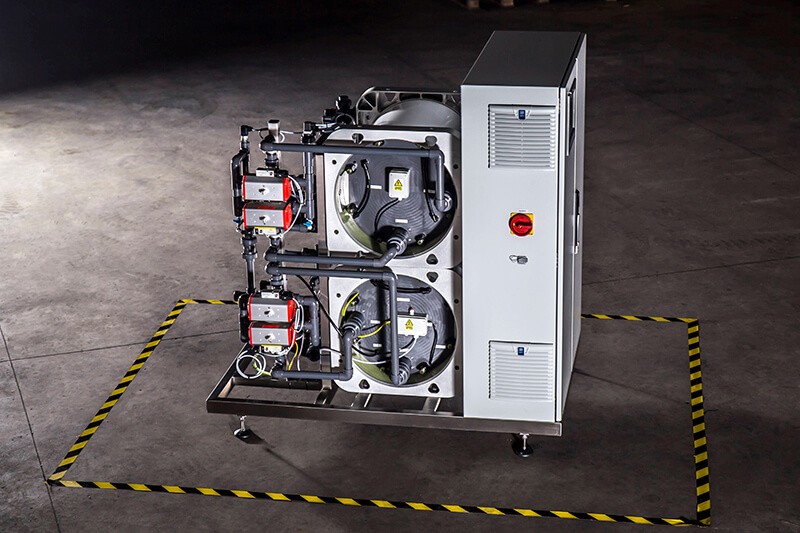Electro Dialysis
Advanced electrodialysis desalination
In recent years Electro Dialysis (ED) has taken a new direction in system design, giving the technique unprecedented capability in desalination and industrial wastewater recovery.
However, the basic operating principle is still the same. Since its introduction in the 1950s, Electro Dialysis has used a DC electrical potential and selectively permeable membranes (permeable to same-charge ions but relatively impermeable to opposite-charge ions and water) to remove ionized materials from aqueous solutions.
In seawater and brackish water desalination applications ED was previously considered too energy-intensive to compete with reverse osmosis (RO). But ED requires less extensive feed water pretreatment than a pressure-driven membrane process, such as RO and Nanofiltration and it also answers the increasing needs of recycling and conservation.
Another important feature, the incorporation of periodic reversal of electrode polarity (EDR), has made the process more tolerant of difficult feed water conditions. By reducing pre-treatment requirements (acid and anti-scaling treatments), polarity reversal has made EDR even more competitive with RO.
General characteristics of ED(R) are:
- Polarity reversal feature to avoid scaling
- Low-pressure operation
- Relatively low lifecycle cost
- Easy maintenance
- Limited pre-treatment needed
- Chlorine compatible
- Because an ED system removes only ionized species, it is particularly suitable for separating non-ionized from ionized components.
How Does Electrodialysis Work?
The function of Electro Dialysis is to divide the input water into concentrated (reject) and dilute (product) streams, transporting dissolved ions by an electrical force. Under a DC potential, negative ions (like Cl-) are attracted towards an anode and positive ions (like Na+) are attracted towards a cathode. Between the two electrodes, a series of compartments are formed by ion exchange membranes. The membranes are stacked alternately, according to their ionic charge, so that the majority of dissolved ions permeate through to the reject streams.
Electro Dialysis features and benefits
In order to rate Electro Dialysis correctly we need to compare it with the main rival techniques, RO and thermal distillation although a combination of the mentioned rival techniques with ED is also not uncommon.
Thermal techniques, such as Multistage Flash Distillation, vaporize the water and recover the purified condensate. Although these distillation methods lower the vapor pressure of the water, so that its boiling point is reduced, they still require a large amount of energy. Consequently they are mostly employed in locations such as thermal power stations, where a source of waste heat is readily available.
Reverse osmosis pressurizes and forces the water through filtration membranes, trapping salt and other minerals. It can be highly effective, removing over 95% of salts from the water supply. However, the RO membranes must be protected from contamination by larger particles and microfiltration pretreatment is necessary.
Electro Dialysis Reversal (EDR)
The ability to reverse the polarity in an EDR module gives the system better tolerance to variations in feed water quality, including waste water with high turbidity. EDR equipment can regulate the amount of salt removal by adjusting the electrical potential applied to the electrodes. As EDR periodically reverses the electrode polarity to drive ionic flow in the opposite direction. It is analogue to ‘backwashing’ a filtration membrane to remove deposits. This self-cleaning capacity reduces scaling and extends the service life of the membrane stack. It can also reduce pre-treatment requirements and widen the area off application to include boiler blowdown and challenging process water waste recovery.
The benefits Of Electrodialysis for desalination
Today’s advanced EDR units are often described as ‘tunable’. In other words, the electrical energy applied can be changed, according to the amount of salt that needs to be driven out of the feed water. When the feed quality improves, the energy requirement reduces and that energy is saved. For example, if water is abstracted from a river estuary, the salt content might vary by a factor of 10 or more but the output quality remains consistent with Electro Dialysis.
This is not the case for RO, which requires a steady, high pressure (70 bar) – and therefore energy input – to deliver consistent quality. Operating at less than 4 bar, Electro Dialysis is a quiet-running and less demanding technology, in terms of the high pressure pumps, valves and piping that are not required.
There are also benefits when it comes to cleaning and maintenance. When an EDR module needs to be cleaned, the clean-in-place (CIP) procedure involves no drop in flow rate, or water quality. The electrical power to the other modules is increased to compensate, maintaining the overall system treatment capacity.
Electro Dialysis modules are relatively compact and these can be stacked on a skid with a very small footprint. In addition, EDR ‘tunability’ offers operators a degree of flexibility in this respect. For a given flow rate and output quality, they can either opt to use more modules and restrict the energy consumption, or reduce the number of modules and increase the energy input.
Our reference projects
For more detailed information please have a look at our reference projects.

How does it work?
Experience, expertise and attention
We believe there are only a few companies in the world to rival what we do.
Thanks to our extensive experience in water treatment solutions for a wide range of applications, we developed essential insights into the EDI, MD and EDR technologies and how they meet specific requirements ‘in the field’. This is reflected in the quality of technical/commercial support, training, service and documentation we provide.
So why not contact us? Our advice is free!
Contact us for further assistance
Interested what Pure Water Group can do for you? Just call us direct or fill out the contact form.
